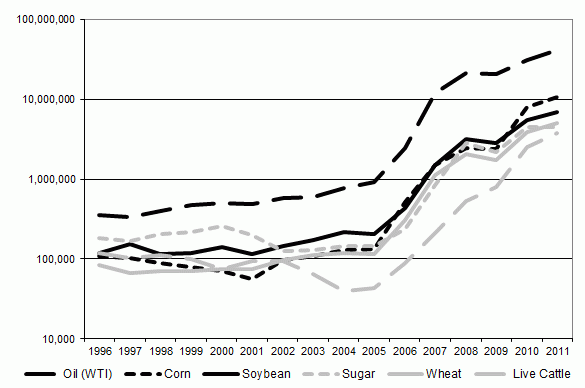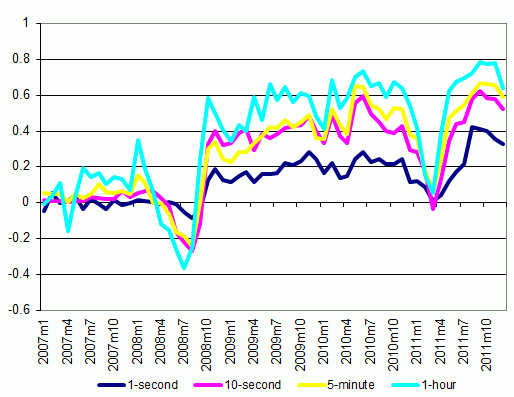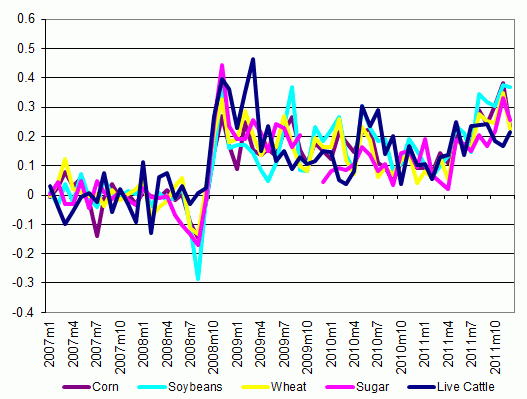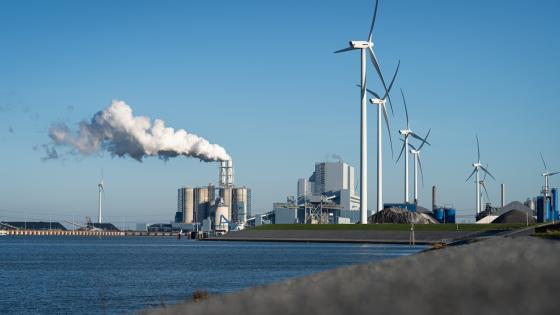What is causing the sharp price movements of many primary commodities? The debate goes on. (See Fattouh et al 2012 on Vox for a recent contribution.) Yet despite the range of views, three developments over the last decade are constantly referred to:
-
First, large developing economies have grown rapidly and steadily, boosting global demand for primary commodities.
-
Second, significant supply shocks like adverse weather and export bans have amplified price movements on some already tight markets.
-
Third, the growing presence of financial investors in commodity markets has become significant. While these developments are widely acknowledged, there is debate whether the ‘financialisation’ of commodity trading has affected commodity prices and their volatility and, ultimately, whether it benefits the commodity markets.
The growing ‘financialisation’ of commodities markets
Investing in commodities through futures markets has gained importance among ever since the burst of the dot-com bubble. Stung by losses, financial investors were on the lookout for a new asset class to diversify their portfolio and reduce their risks. The seminal paper by Gorton and Rouwenhort (2006) – showing that commodity futures have historically offered the same return as equities but are negatively correlated with equity and bond returns owing to different behaviour over the business cycle – supported this diversification strategy.
Investment in commodities became a common part of a large investor portfolio allocation, which coincides with a significant increase of assets under management of commodity indexes. From less than $10 billion around the end of the last century, commodity assets under management reached a record high of $450 billion in April 2011 (Institute of International Finance 2011). Consequently, the volumes of exchange-traded derivatives on commodity markets are now 20 to 30 times greater than physical production (Silvennoinen and Thorp 2010). Similarly, financial investors, which accounted for less than 25% of all market participants in the 1990s, now represent more than 85%, in some extreme occurrences, of all commodity futures market participants (Masters 2008).
Does financialisation benefit the commodity markets?
The benefits of these developments have been debated. On the one hand, the proponents would argue that the presence of new players in the commodities markets would ease the price discovery problem and bring the price closer to its underlying fundamentals. In addition, it would provide further liquidity and transfer risks to those who are better prepared to take them on.
On the other hand, a growing number of studies provide evidence of price distortions linked to the financialisation of commodity markets (see UNCTAD 2011: Chapter 4.5, for an overview). According to Tang and Xiong (2011) and UNCTAD (2011) one manifestation of this pattern is reflected in the growing correlation between commodities and stock indices, owing to the growing importance of index trading. By contrast, Stoll and Whaley (2010) and (2011) conclude that commodity index flows have little impact on futures prices. Using non-public data from the Commodity Futures Trading Commission, Büyükşahin and Robe (2011) show that the daily correlation between the returns on commodity and equity indices soared after the demise of Lehman Brothers and remained exceptionally high through the winter of 2010. Their econometric analyses suggest that, besides macroeconomic fundamentals, hedge fund positions help explain changes in the strength of equity-commodity linkages. Unfortunately, their data do not allow them to distinguish between the types of hedge fund activities behind these positive correlations. Moreover, they cannot track the activities of market participants who do not hold position at the end of the day, because these actors do not have the obligation to report to the Commodity Futures Trading Commission. This leaves many unanswered questions regarding the determinants of these growing co-movements, in particular the role of economic fundamentals or of other type of investment strategies.
The rise of high-frequency trading
Looking at intra-day and high-frequency data allows us to get a firmer grip on some of the recent technical developments that have affected the commodity markets. Since 2005, pit trading has become more marginal and full electronic trading – which allows almost uninterrupted trading around the clock – has been introduced on the main commodity exchanges. Due to lower transaction costs, electronic trading has led to a sharp increase in the number of transactions and the volumes involved (Figure 1). Indeed, between 2005 and 2007, trades increase from about 380% up to 1200% on selected commodity markets. For the period between 2007 and 2011, the increase remains substantial, ranging from about 160% to 1100%. In addition, full electronic trading also paved the way for new types of market participants, including some with very short-term investment horizons like high-frequency trading strategies, which use algorithms and robots for their operations.
Figure 1. Number of annual trades by commodity, 1996–2011
Note: The y-axis is a logarithmic scale of base 10.
Source: Bicchetti & Maystre (2012) calculations based on Thomson Reuters Tick History database.
Evidence from high-frequency data
In recent research (Bicchetti and Maystre 2012), we analyse the short-term co-movements between returns on several commodity markets and on the US stock market over the 1997–2011 period, using tick data. We compute various rolling correlations at higher frequencies than the daily one, which remains the standard in existing literature. We analyse the co-movement of the returns of the futures contracts of oil (WTI) with the S&P 500 E-mini futures at high frequencies, including one-hour, five-minute, ten-second and even one-second intervals (Figure 2). We find a synchronised structural break across commodity markets, which starts in September/October 2008 and continues until the latest observation of our dataset, the end of 2011. However, we observe a temporary decline in the correlation in 2011Q1 that we attribute to the Libyan uprising.
Figure 2. Monthly median of short-term rolling correlations between the returns on the WTI and the S&P 500 futures, by frequency, 2007m1–2011m12
Source: Bicchetti & Maystre (2012) calculations based on Thomson Reuters Tick History database.
We find similar results when we look at the correlation between the E-mini S&P 500 futures and five soft commodities futures (corn, soybeans, wheat, sugar, and live cattle). Soft commodities are supposed to differ even more from the US equities market than the ones for crude oil because their economic fundamentals. Yet, all these commodities present a similar pattern, except during 2011Q1, when there is no clear decline in the correlations.
Figure 3. Monthly medians of the five-minute rolling correlations computed over 75 minutes between the returns on selected soft commodities and the S&P 500 futures, 2007–11
Source: Bicchetti & Maystre (2012) calculations based on Thomson Reuters Tick History database.
Before 2008, high-frequency co-movements between commodity and equity markets rarely differed from zero. But during 2008 these correlations departed from zero and became strongly positive after the collapse of Lehman Brothers. The persistence of this trend until December 2011 remains difficult to explain. Further research is needed to get a complete understanding of the mechanisms at work behind this structural change. Yet, given the high frequencies, we think that high-frequency trading strategies, in particular the trend-following ones, are playing a key role. We believe a combination of factors made that change possible.
-
First, financial technical innovation spurred high-frequency trading through the gradual introduction of full electronic trading on exchange platforms since 2005.
-
Second, investors moved away from passive strategies and opted for active ones when the rising trends on equity and commodity markets stopped, in particular since the fall of 2008.
-
Third, lasting uncertainties and positive feedback effects reinforced this trend.
Why does it matter?
In our view, this finding adds to the growing empirical evidence supporting the idea that the financialisation of commodity markets has an impact on the price determination process. Indeed, the recent price movements of commodities are hardly justified on the basis of changes of their own supply and demand. In fact, the strong correlations between different commodities and the S&P 500 at very high frequency are really unlikely to reflect economic fundamentals since these indicators do not vary at such speed. Moreover, given the large selection of commodities we analyse, we would expect to have different behaviours due to their seasonality, fundamentals, and specific physical market dynamics. Yet, we do not observe these differences at any frequency. In addition, the fact that these correlations at high frequencies started during the 2008 financial shock provides additional support for the idea that there are financial-based factors behind this structural change. Therefore, the very existence of cross-market correlations at high frequencies favours the presence of automated trading strategies operated by robots on multiple assets. Our analysis suggests that commodity markets are more and more prone to events in global financial markets and more likely to deviate from their fundamentals.
This result is important for at least two reasons. First, it questions the diversification strategy and portfolio allocation in commodities pursued by financial investors. Second, it shows that, as commodity markets become financialised, they are more prone to external destabilising effects. In addition, their tendency to deviate from their fundamentals exposes them to sudden and sharp corrections.
The views and opinions expressed herein are those of the authors and do not necessarily reflect those of the United Nations Conference on Trade and Development.
References
Büyükşahin, B and Robe MA (2011), “Speculators, Commodities and Cross-Market Linkages”,mimeo.
Gorton, G and KG Rouwenhorst (2006), “Facts and Fantasies about Commodity Futures”, Financial Analysts Journal, 62(2):47–68.
Institute of International Finance (2011), “IIF Commodities Task Force Submission to the G20: Financial Investment in Commodity Markets: Potential Impact on Commodity Prices & Volatility”, September.
Masters, M W(2008), “Testimony of Michael W. Masters before the Committee on Homeland Security and Governmental Affairs”, United States Senate, 20 May 2008.
Sheppard, D (2011), “NYMEX oil trade 45 percent computer-driven”, Reuters, 3 March.
Silvennoinen, A and S Thorp (2010), “Financialization, Crisis and Commodity Correlation Dynamics”, Research Paper 267, Quantitative Finance Research Centre, University of Technology Sydney.
Stoll, HR and RE Whaley (2010), Commodity Index Investing and Commodity Futures Prices, Journal of Applied Finance, 20(1):7–46.
Stoll, HR and RE Whaley (2011), “Commodity Index Investing: Speculation or Diversification?”, The Journal of Alternative Investments, 14(1):50–60.
Tang, K and W Xiong (2011), “Index Investment and Financialization of Commodities”, Princeton University, March.
UNCTAD (2011), Price Formation in Financialized Commodity Markets: The Role of Information, United Nations.





